
The Bromeliaceae are a family of monocot flowering plants of about 80 genera and 3700 known species, native mainly to the tropical Americas, with several species found in the American subtropics and one in tropical west Africa, Pitcairnia feliciana.

Puya is a genus of the botanical family Bromeliaceae. It is the sole genus of the subfamily Puyoideae, and is composed of 226 species. These terrestrial plants are native to the Andes Mountains of South America and southern Central America. Many of the species are monocarpic, with the parent plant dying after one flower and seed production event.
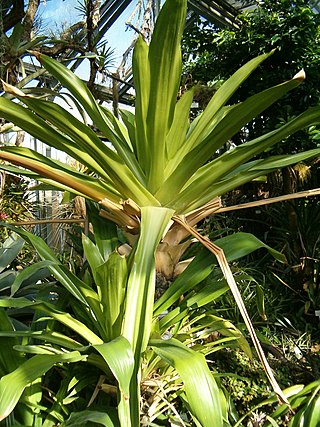
Brocchinia is a genus of the botanical family Bromeliaceae, and is the sole genus of the subfamily Brocchinioideae, containing 20 species. The genus is named for Giovanni Battista Brocchi, Italian naturalist (1772–1826). Brocchinia species are native primarily to the ancient Guayana Shield in southern Venezuela and Guyana, with some species extending into Colombia and northern Brazil. Its species are generally restricted to areas of sand and sandstone of the Roraima Formation; a few occur on granite.
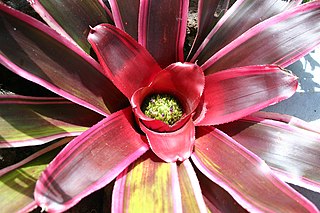
Neoregelia is a genus of epiphytic flowering plants in the family Bromeliaceae, subfamily Bromelioideae, native to South American rainforests. The genus name is for Eduard August von Regel, Director of St. Petersburg Botanic Gardens in Russia (1875–1892).
Brocchinia uaipanensis is a species of bromeliad endemic to southern Venezuela. It has been treated as the sole species in the genus Ayensua under the synonym Ayensua uaipanensis, but Ayensua is now included in Brocchinia. The species was first described in 1957 by Bassett Maguire as Barbacenia uaipanensis.
Brewcaria is a genus of plants in the family Bromeliaceae. The genus is named for Charles Brewer-Carías, Venezuelan explorer and naturalist. Some authorities treat Brewcaria as a synonym of Navia. It contains 6 known species, all native to Colombia and Venezuela.

Cryptanthus is a genus of flowering plants in the family Bromeliaceae, subfamily Bromelioideae. The genus name is from the Greek cryptos (hidden) and anthos (flower). The genus formerly had two recognized subgenera: the type subgenus and subgenus HoplocryptanthusMez which has been raised to the separate genus Hoplocryptanthus. All species of this genus are endemic to Brazil. The common name for any Cryptanthus is "Earth star".

Bromelioideae is a subfamily of the bromeliads (Bromeliaceae). This subfamily is the most diverse in the family, represented by the greatest number of genera with about 40. Most of the plants in this group are epiphytes, though some have evolved in, or will adapt to, terrestrial conditions. This subfamily features the most plant types which are commonly cultivated by people, including the pineapple.

Pitcairnioideae is a subfamily of the bromeliad family, Bromeliaceae. Traditionally, it was a large subfamily, comprising all those species with winged or more rarely naked seeds. Molecular phylogenetic studies showed that traditional Pitcairnioideae was not monophyletic, and the subfamily was more narrowly circumscribed. As of November 2022, the Encyclopaedia of Bromeliads placed five genera in the subfamily. Members of the subfamily are found from the Andes to the coast of Brazil, with one genus (Fosterella) found northwards to Mexico.
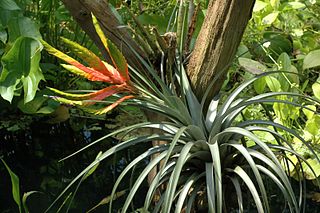
Tillandsioideae is a subfamily of plants in the bromeliad family Bromeliaceae. This subfamily contains the greatest number of species. Most are epiphytic or lithophytic, growing in trees or on rocks where they absorb water and nutrients from the air. Spanish moss of the genus Tillandsia is a well-known species. Bromeliads in the genera Guzmania and Vriesea are the more commonly cultivated members of this subfamily.

Navia is a genus of plants in the family Bromeliaceae, containing 95 species. Described as early as 1830 in Guyana, they are commonly cultivated for their colorful foliage and inflorescences. All the species are native to northern South America.
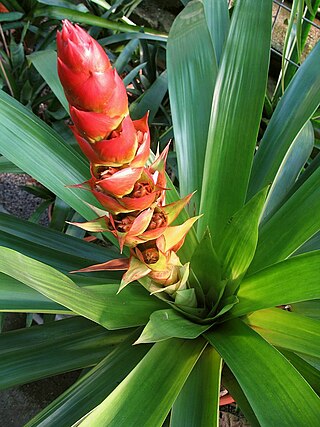
Mezobromelia is a genus of the botanical family Bromeliaceae, subfamily Tillandsioideae. The genus name is for Carl Christian Mez, German botanist (1866-1944). Some authorities treat Mezobromelia as a synonym of Cipuropsis.

Pitcairnia subg. Pepinia is a subgenus of plants in the family Bromeliaceae. It has at times been treated as the separate genus Pepinia, but is now included again in the genus Pitcairnia. The name is for Pierre Denis Pépin, French member of the Imperial and Central Society of Agriculture (c.1802-1876).
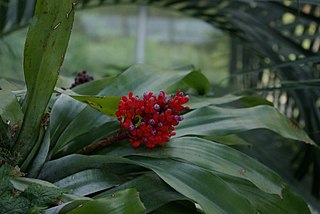
Lamprococcus is a subgenus of the genus Aechmea.
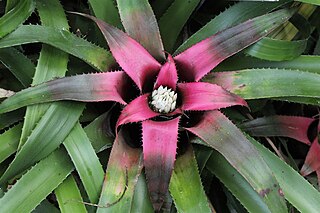
Hylaeaicum is a genus of flowering plant in the family Bromeliaceae, native to tropical northern South America. The taxon was first described by Ernst Heinrich Georg Ule in 1935 as a subgenus of "Aregelia". It was later treated as a subgenus of Neoregelia, before being raised to a full genus in 2021, a status accepted by both Plants of the World Online and the Encyclopaedia of Bromeliads.
Cipuropsis is a genus of flowering plant in the family Bromeliaceae, native to the Caribbean, southern Central America and northwestern South America. The genus was first described by Ule in 1907.
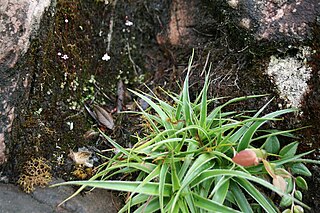
Lindmanioideae is a subfamily of the bromeliad family, Bromeliaceae. It contains two genera, which were formerly placed in a more broadly defined subfamily Pitcairnioideae.

Tillandsia subg. Tillandsia is a subgenus of the genus Tillandsia.
Josemania is a genus of flowering plant in the family Bromeliaceae, first described in 2016.

Rokautskyia is a genus of flowering plant in the family Bromeliaceae, native to eastern Brazil. The genus was first established in 2017, and is placed in subfamily Bromelioideae.
















